Adelaide’s Marineland Dolphins
by Steve Reynolds
Adelaide had a marine park called Marineland between 1969 and 1988. It was located at West Beach. The park closed in 1988 “amid mounting opposition to keeping animals for public entertainment”.
I had probably visited the park a couple of times over the 19 years that it was open. I would’ve seen the dolphin show on those occasions.
Society members were able to dive in one of the dolphin pools at Marineland the year before it closed. I was our Society’s President even back then in 1987. I was also our newsletter editor back then.
I wrote a report about our dive with dolphins at Marineland in our October 1987 newsletter. That report tells me that the visit occurred in September 1987. We had a group of twenty members on the day. Thirteen of us did the actual dive in the pool with two dolphins. The other seven members were able to either watch us dive or visit all of the marine life displays.
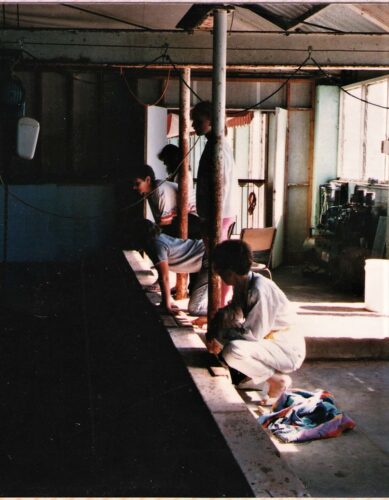
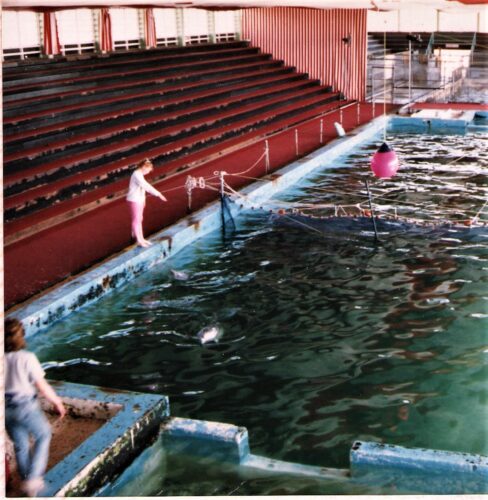
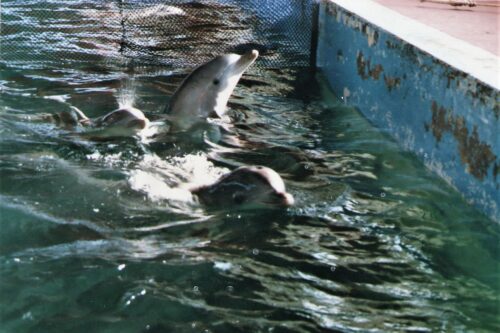
The dolphin aquarium (or pool) was just 2m deep. There were just two dolphins in the pool. All of the divers enjoyed the experience swimming with them. Other inhabitants in the pool included some huge crayfish, a couple of large spider crabs, a big leatherjacket and one or two sea urchins. Most of our attention was on the two dolphins though.
The visibility in the water was good and it seems that my own dive time was just short of one hour, although I recall that the number of divers allowed in the pool at any one time was restricted.
The pool had viewing windows for our members to observe our antics with the dolphins. We, ourselves were also able to observe the diners eating in the Marineland “Dine with Dolphins” restaurant whilst we were diving. My biggest memory is of me reaching out to try to touch a passing dolphin which promptly nibbled on my outstretched fingers.
(I still tell the tale of how I have never been bitten by a shark, but I have been bitten by a dolphin!)
We were able to inspect all of Marineland’s other attractions after our dive. That may well have included a dolphin show. At least one of the performing dolphins in Marineland’s early days would leap through a ring of fire. I had a couple of postcards featuring a dolphin leaping through the fiery ring. I donated one of these postcards to the SA Maritime Museum for its dolphin display. That postcard has been on display there for many years. The caption under the postcard mentions the Marine Life Society of SA alongside my name.
I still have this second postcard featuring the (same?) dolphin leaping through the ring of fire: –
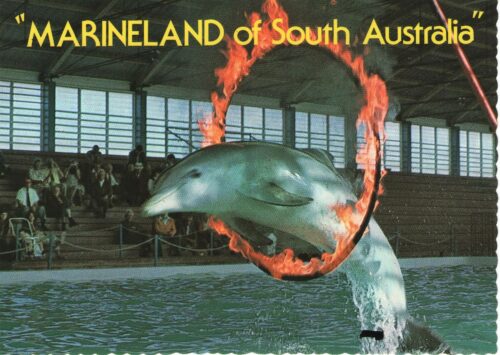
The caption on the back of the card reads, “The spectacular Fire Hoop Leap”.
The Advertiser of 4th May 2020 features a similar photo of a Marineland dolphin leaping through a ‘fire hoop’. The photo is part of the Boomer section’s “The Way We Were” column (“What was making news in The Advertiser 50 years ago this week”).

It came from The Advertiser of 5th May 1970. Text from the newspaper report was repeated below the photo. It seems that back in 1970, Marineland used some local fishermen to catch their exhibits for them, including dolphins. They caught, for example, a dolphin for Marineland at Outer Harbor about March 1970.
This male dolphin was placed in one of Marineland’s dolphin pools and he was given the name of “Nipper”. It didn’t take Nipper very long to be trained to perform tricks. Within eight weeks, he was jumping through a burning hoop. It was believed at that time that Nipper was the only dolphin in Australia that did such a thing.
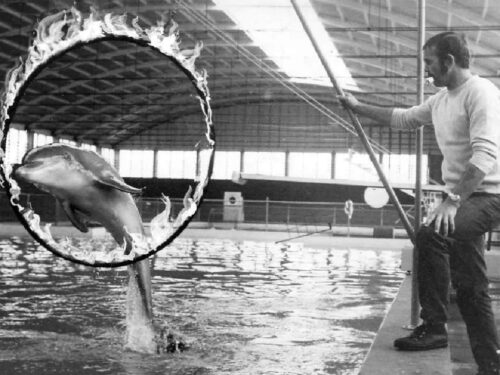
Nipper leaping through a hoop of fire at Marineland in 1970
Marineland closed down in 1988. What to do with all of the fish and other creatures in some of the large pools was a problem though. The Marine Life Society of SA came to the rescue. Society members collected all of the creatures up (as shown in the following two photos) and transported them to the nearby Buffalo Restaurant where they were transferred into the restaurant’s aquarium: –
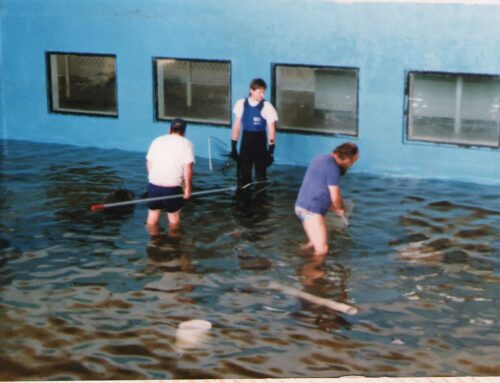
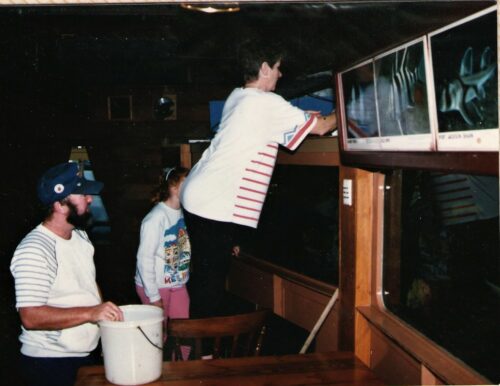
The aquarium at the Buffalo restaurant was later shut down, and the restaurant itself also closed eventually, before being demolished.
When Marineland closed down in 1988, there was much concern regarding what to do with the six dolphins (and seals & pelican, etc..) that were there. There were issues no matter what solution was chosen. Could the dolphins be released into the wild, could they be housed in an outside pen somewhere, or could they be sold overseas, etc..? In 2015, I wrote online at http://www.adelaiderememberwhen.com.au/mixed-memories-for-marineland/ that 6 dolphins were sent by air to SeaWorld on the Gold Coast.
I also reported that MLSSA has a 28-page booklet published by Marineland (West Beach Trust) in the early days. This booklet features two photos of Nipper performing his fire hoop leap.
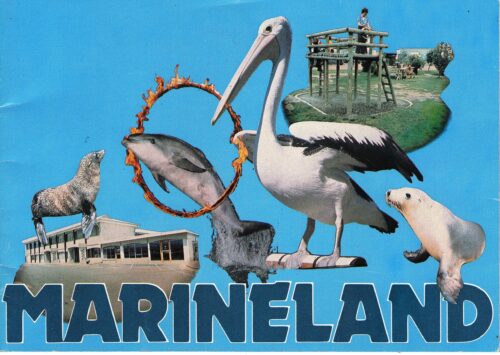
(Apart from the obvious scanned photos above, the photos from our Marineland visits come from our Society archives)
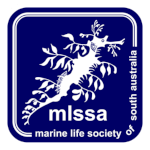
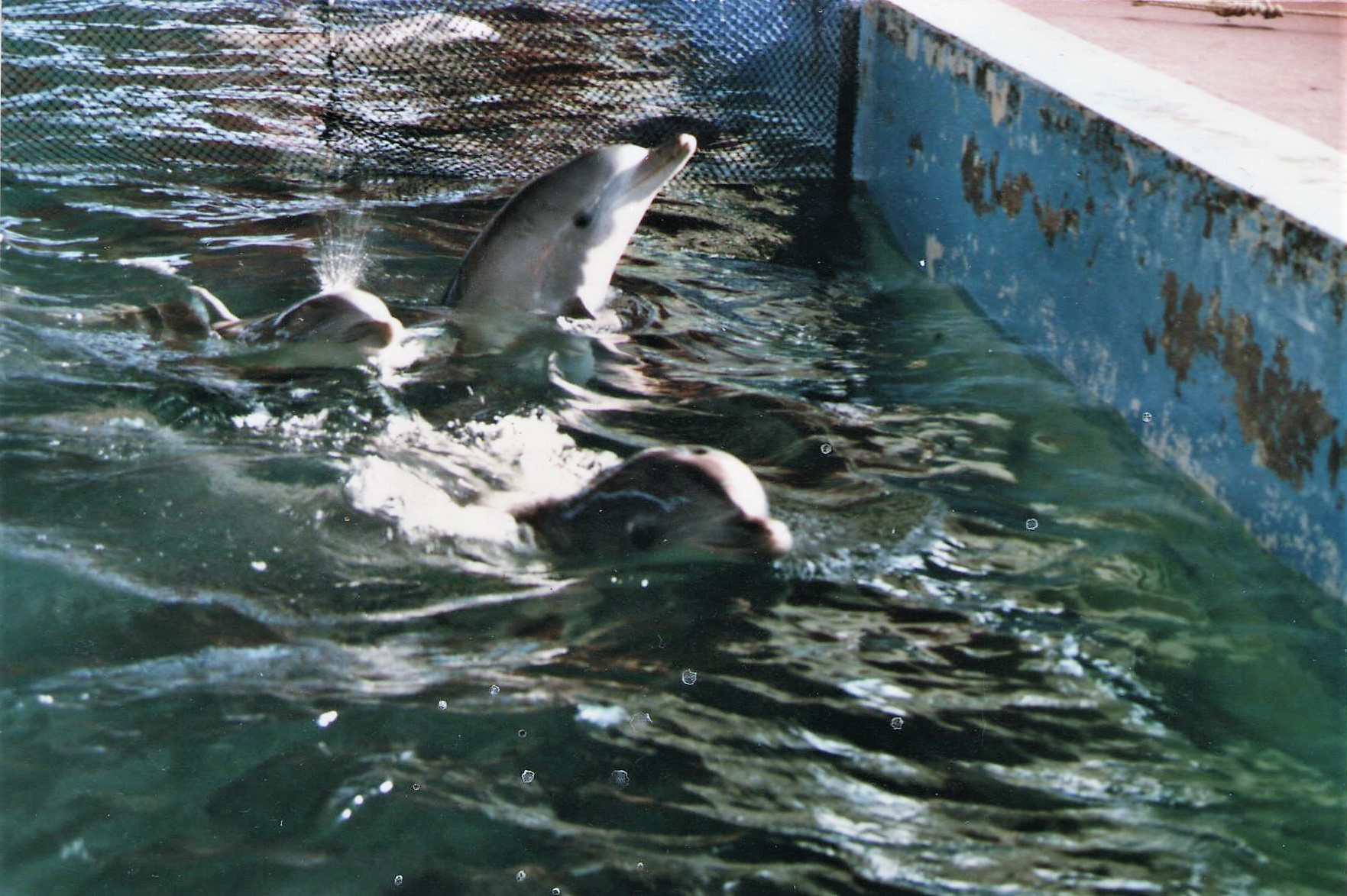
According to Mike Bossley of WDC, at least one of the Marineland dolphins was released into the wild locally and rejoined the Port River pod, where he/she taught other dolphins how to tail-walk. That behaviour lives on today in subsequent generations of the population… a great demonstration of the way dolphins are able to pass knowledge down from generation to generation.
That dolphin was Billy/Billie. She had become trapped in the Patawalonga Lake at Glenelg in 1988 (something that occurs regularly now). She was subsequently rescued from the lake I, myself, had been involved in an earlier dolphin rescue near Outer Harbor. I was, however, unable to assist in this latest rescue attempt, so I enlisted the help of Frank Wendland, another Marine Life Society member. The dolphin was rescued, with Frank’s help, and was taken to Marineland until she could be released back in to the wild.
Billy/Billie was the same dolphin that had become a celebrity in 1987 when she was photographed by the late Martin Jacka, a former News Ltd photographer, swimming alongside racehorse trainer Sandy Sandford’s horse and dog in the Port River. She was named Billy by Sandford, but this was changed to Billie when it was realized that she was a female dolphin. She disappeared from the river in 1988 and turned up in the Patawalonga Lake.
Whilst Billie was being kept at Marineland after being rescued from the Patawalonga Lake, she copied the regular captive dolphins there and started tailwalking. This involved standing upright in the water and running backwards.
Marineland closed in 1988. Billie was returned to the Port River about this time, and she continued to tailwalk there. Her antics were soon picked up by other Port River dolphins, including Wave and, later on, her daughter Ripple. Wave was known to do as many as 50 tailwalks a day.
Billie was in her mid-20s when she prematurely died of kidney failure in 2009.
I was a trainer at Marineland. No captive resident dolphin was ever released into the wild, only 3 rescued/rehabilitated were released (2 Common dolphins named Henley and Stormy washed up on the beaches during a storm in 1987, and 1 Bottlenose after being trapped inside the lock in the Pattawalonga marina early 88). None of the rescued dolphins were ever placed with the 6 resident dolphins, so the tailwalking story is purely mythical. Dolphins will tailwalk, jump, spin and do all the behaviours mentioned as natural manoeuvres. We had the female bottlenose at Marineland for 3 weeks, and she was kept in an outdoor pool (the old sealion pool) and never saw the other dolphins. She was released without incident at West Beach after being freeze branded on her dorsal. We never named her Billie, that was media hype.
Thanks very much for adding details to the Marineland story, Jo. Those details clear up a few myths and questions.
Hi Jo, can you remember the names of the dolphins. I’m thinking they were Rebel, Zipper, Cheeky, Splash and Buttons. Splash had a baby, Tuffy. Or something like that. Does this sound right?
[…] reading my recent article about Adelaide’s Marineland Dolphins, Dan Monceaux made the following comment: […]
My interview on the Marineland feature on Ch 7 News on 17th Feb 2021 can be found at https://www.instagram.com/p/CLYy0GZhNxG/?fbclid=IwAR1-_6s_hREl2wOGgHnKdmEXUKV3_UTPvxtqKE4BfsGeKU0ieuLPUTYdgm0
Two of the seals were rehomed at the Lonsdale RSPCA shelter, they had facilities for marine mammals at that time. The pools have been filled in with concrete and their indoor facilities are now an isolation house for animals infected with ringworm, but the plaques telling the story about the seals are still there. They say the following:
“Orson, a male Australian sealion was transferred to the RSPCA from Marineland as a result of its closure on the 11th April 1990.
Orson was originally captured in January 1988 whilst resting beneath a floating pontoon at Port Adelaide. He was suffering from respiratory problems and peritonitis. An x-ray revealed he has an enlarged heart which would prevent him from ever being released from captivity.”
“Speedy, a female Australian sealion, was one of four to be captured at Kangaroo Island by the West Beach Trust in October 1978. She was transferred to the RSPCA marine rescue unit from Marineland on the 11th April 1990.
Speedy although otherwise healthy has suffered from epileptic seizures since July 1984 for which she is receiving daily medication. This medical condition prevents Speedy from being released and therefore will remain in captivity.”
[…] writing about Marineland’s dolphins in 2020, I have been interviewed by both Channel 7 Adelaide News’ “Flashback” and […]
I worked at Marineland West Beach and got to know the female porpoise well while I was there.She was aggressive so only the strongest swimmers were allowed to get into the pool with her.A wonderful experience for me and her-she was fretting,afterI left, I heard.
Thanks for these details, Adam
g.day mate I am bryan kirshon from the USA I am a conservationist I want to subscribe to emails for the newsletter please 🐬